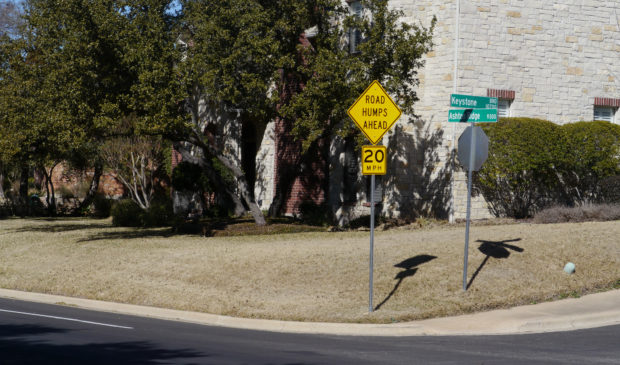Transportation Department defends ‘speed cushions’
Tuesday, February 13, 2018 by
Jack Craver Transportation Director Robert Spillar showed up at a meeting of the Public Safety Commission on Monday to defend “speed cushions,” the traffic-calming devices that have infuriated motorists across the city, most notably in a Northwest Austin neighborhood that successfully campaigned to have them removed.
“We hate to put them out there, but the other side of the story is they’re really effective at getting people to drive a more safe and reasonable speed,” said Spillar.
Tests the department has run near speed cushions have shown that cars slow down significantly in response to them. “We find that we get good compliance, quite honestly,” he said.
Spillar also rejected the idea that the cushions caused serious pain to drivers: “If you slow down, we maintain that there is little to no pain caused.”
How slow? Spillar said cars should be slowing down to 10 miles per hour. He recognizes that isn’t necessarily popular.
“That is an irritant for folks on streets posted at 30 miles per hour,” he said.
There’s a big difference in terms of safety between a car going 30 miles per hour and one that is going 40. The former has a 50 percent chance of killing a pedestrian it strikes, while the latter will kill a pedestrian 90 percent of the time.
Nevertheless, Spillar acknowledged that there are concerns around the country about the impact that the cushions have on those with certain spinal conditions. The city of Boulder, Colorado, he said, had decided against putting them in place “out of an abundance of caution” of running afoul of the Americans with Disabilities Act.
The city of Austin, however, is confident that the cushions are legally sound. At the very least, the Transportation Department is not aware of any successful lawsuits against the devices or other relevant case law that would suggest that the cushions are illegal.
Those assurances did not assuage John Woodley and Karen Sironi, who showed up for the second time to the commission’s meeting to plead for the cushions’ elimination, arguing that the department’s insistence on maintaining them showed a callous disregard for those suffering from musculoskeletal issues.
“They do not care that they are hurting people,” said Sironi, who has said that going over the cushions is extremely painful for her due to a spinal injury she suffered in a car accident years ago.
Commissioner Noel Landuyt wondered if there are effective – and perhaps less annoying – alternatives to speed cushions, such as simply lowering the speed limit on a street. The problem with that, replied Spillar, is that people don’t obey speed limits. Instead, people tend to drive the speed they believe makes sense based on the design and size of the street.
What type of factors get people to slow down? Narrower streets help, as does on-street parking. The more cluttered the street feels, the more hesitant drivers are to press on the gas.
“A lot of people think that on-street parking makes it more dangerous; it actually makes it safer,” said Spillar.
Asked why the department is opting for the rubber speed cushions as opposed to the traditional asphalt humps, Spillar explained that the new devices can be spaced so that emergency vehicles don’t hit the bumps at all. In fact, Spillar noted, large SUVs can evade the cushions as well.
In Austin’s experience, the rubber cushions have cost significantly less than the asphalt humps, which Spillar acknowledged were a little bit “gentler.” However, transportation staff is aware of other cities that have been able to install asphalt for much less money.
“So we’re asking those other cities how they achieve that,” said Spillar.
A solution that makes everybody happy just isn’t always possible, he explained.
“Every time we go into a neighborhood, there’s always debate,” he said. “We try our best to work those differences (among neighbors) out, but in the end, it comes down to an engineering recommendation that we have to carry forward.”
Photo courtesy of the city of Austin.
The Austin Monitor’s work is made possible by donations from the community. Though our reporting covers donors from time to time, we are careful to keep business and editorial efforts separate while maintaining transparency. A complete list of donors is available here, and our code of ethics is explained here.
You're a community leader
And we’re honored you look to us for serious, in-depth news. You know a strong community needs local and dedicated watchdog reporting. We’re here for you and that won’t change. Now will you take the powerful next step and support our nonprofit news organization?









